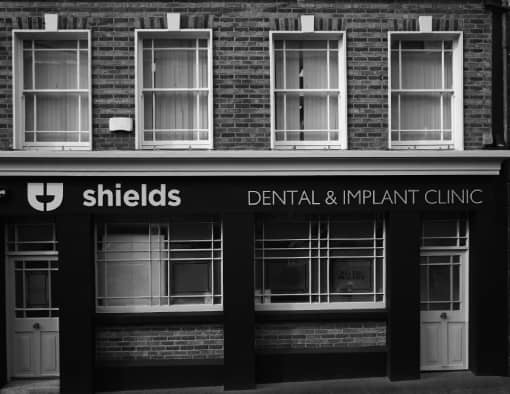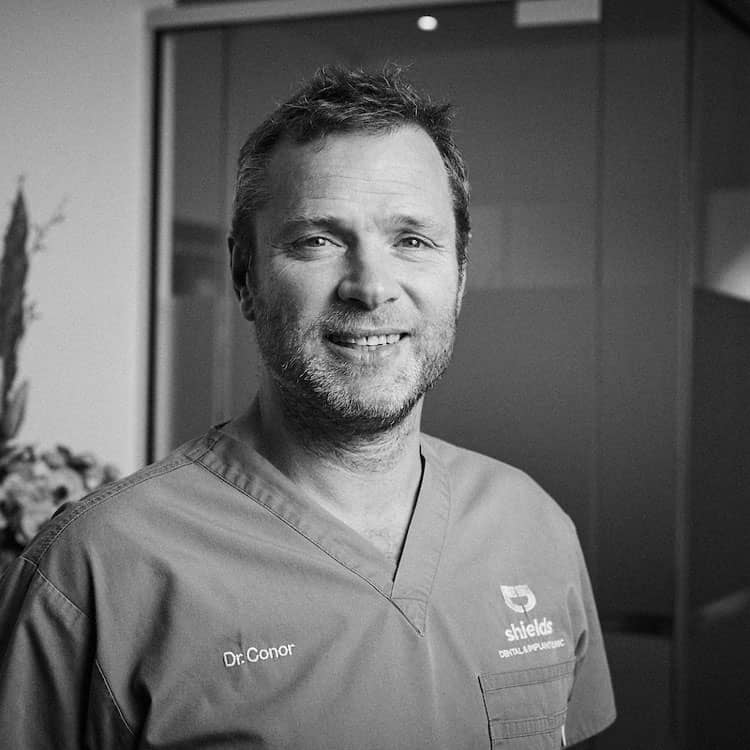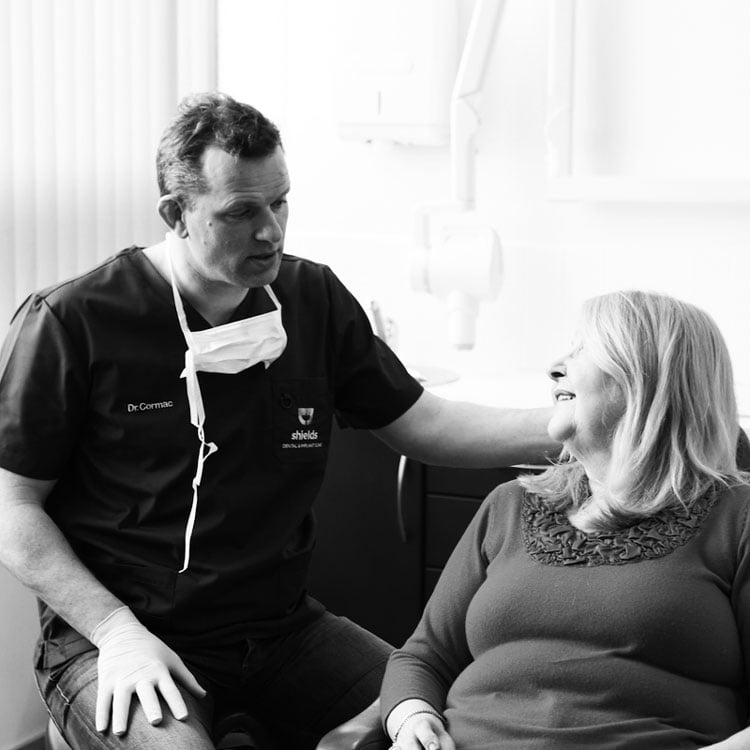Durable and versatile, they give you and your orthodontic dentist complete control.

How they
work.
Metal Braces are composed of a series of parts including brackets that are bonded to the front of the teeth, connected to archwires that move the teeth. This is tightened periodically during a one- to two-year treatment period. Some braces include springs on the archwires between brackets that either push, pull, open or close gaps between the teeth.
Your
consultation.
As with all the treatments available at Shields Dental & Orthodontic Clinics, orthodontic treatment strategies are devised following a full discussion with the patient, and an in-depth analysis to determine the precise problems arising from (and the precise characteristics of) a malocclusion.
Our orthodontic dentist in Limerick are expert in tooth movement and have many years of expertise in administering a range or orthodontic treatments for all age groups. Treatment will be geared towards the specific needs, and wishes, of the patient in each case. We provide Childrens orthodontics and Adult orthodontics at our dental practices in Limerick, Castletroy and Roscrea.


How to make an orthodontic
appointment.
FAQs.
Invisible item
Why might I need orthodontic treatment?
Cosmetically, there may be an aspect of your smile that is causing you to conceal or inhibit it. Typical problems include crooked or crowded teeth. They may stick out or have gaps between them that you think are unsightly. A malocclusion can lead to other dental problems, including excessively worn, chipped and broken teeth, and Temporomandibular Joint Dysfunction (TMD).
What is malocclusion and TMD?
Occlusion is the dental term used to describe the way the teeth meet when the jaws bite together. A malocclusion, and irregularity in the way the teeth meet, may be a symptom of—or cause—problems with the temporomandibular joint that connects the lower jaw and the skull. The technical term referring to these problems in the jaw and the muscles in the face that control it, is Temporomandibular Joint Dysfunction (TMD).
What does treatment involve?
Treatment begins with the orthodontic dentist undertaking an in-depth study of the mouth and jaw, using x-rays, in order to devise a strategy for moving the teeth into position. The method most often chosen is fixed braces, which will typically be adjusted and tightened every six weeks for a duration of one to two years.
Metal brace or ceramic braces?
The construction of ceramic braces is very similar to the metal variety, with the difference that the brackets bonded to the front of the teeth are clear or tooth-coloured. These are less conspicuous than metal braces, although the ceramic brackets can cause wear on the teeth. An orthodontic dentist will carefully consider and evaluate the way the patient’s teeth overlap when closed before deciding to proceed with ceramic braces. The ligatures, the elastic bands that hold the archwire (which is tightened every six weeks) are either white or clear. These are changed every time the braces are adjusted.
The advantages of metal braces over ceramic are as follows:
- Treatment time tends to be shorter because they tend to be less fragile than ceramic braces.
- Because of this, costs tend to be lower for metal braces
- They are less likely to discolour because they are made from stainless steel. Ceramic braces on the other hand can look discoloured with the build up of tartar and plaque. However, brushing and flossing each day will counteract this.
You can read more about the advantages and disadvantages of metal and ceramic braces here.
How long does treatment take?
The duration of orthodontic treatment depends upon the nature of the problem, and the appliance chosen to address it. For example, using Invisalign aligners to correct crowding of one or two teeth can take just six to 14 weeks. Traditional braces may have to be worn from 6 up to 24 months. If you think you may require orthodontic treatment, Our treatment coordinators and orthodontic dentist will discuss all of the various options with you, prior to embarking on treatment.
What is the aftercare once braces are removed?
Things you can do at home to care for your teeth after braces include:
Schedule a professional exam and cleaning
After having braces, you are well aware of how challenging it can be to keep your teeth clean. Now that they are off, it’s a good idea to schedule an exam and thorough, professional cleaning. While at the dental practice, you have the option of whitening treatment, too. This can help get rid of any stains or yellowing that may be present.
Wear your retainer
Your teeth are naturally inclined to move back to their original position. In fact, the biggest risk of this happening is within the first few weeks after you have gotten your braces off. The retainer is going to keep your teeth where they are supposed to be.
Adopt a thorough oral health care routine at home
Braces are a big investment. Now that they are off, it’s important to follow a good daily dental routine. This can help you keep the beautiful and healthy smile you worked so hard to get. Some of the things you need to do each day include:
- Brush your teeth: At least two times a day using a soft bristled brush. Also, replace your toothbrush every three or four months.
- Floss once a day: By flossing one time a day, you can remove food particles and plaque that your toothbrush can’t reach. Be sure you are flossing each space in between your teeth.
- Use mouthwash: This is optional, however, if your teeth need a bit more protection than just brushing and flossing, speak to your dentist about the right mouthwash options for your needs. This also gives you nice, fresh breath.
- Clean your retainers: This needs to be a part of your daily routine. After it becomes a habit, it won’t feel so much like a chore.
What is the cost of metal braces?
Click here to see our prices. You can spread the cost of treatment over regular intervals with a finance plan.
Book a free consultation with a treatment coordinator and together we will work out a payment schedule that works for you.
Behind every smile there's a story.
The staff at Shields Dental & Orthodontic Clinic, Limerick, are committed to delivering excellent care, aiming to make your visit as comfortable as possible. We strive to create a welcoming and friendly atmosphere in our clinics. Our team provides comprehensive service, looking after you from your initial contact through to your final follow-up appointment.
Here some of our patients tell you about their experience and how happy they are with their smile transformations.
Our
treatments.
From the regular check-up to the specialist and advanced treatments that are needed throughout life, we always use state-of-the-art equipment and latest recommended techniques.

Open 7 days*
Highly trained specialists and dentists
Your safety is guaranteed in our hands
Payment options
Technically advanced
Convenient locations
No obligation consultations
Find out what makes us different.
Recent Reviews.

SCR, Limerick, Shields Dental & Orthodontic Clinic

Castletroy, Limerick, Shields Dental & Orthodontic Clinic

Roscrea, Tipperary, Shields Dental & Orthodontic Clinic

Blackrock, Dublin, Shields Dental & Orthodontic Clinic
Convenient
locations.
You don’t have to go to Beverly Hills to look good, you can go local. In convenient locations in Limerick, Castletroy, Roscrea and Blackrock Dublin. Comfortable but advanced, friendly but professional. Click on your preferred location in the menu or use the arrows to discover more.
For the
smile you have
always wanted.
Use our FREE consultation service to speak to one of our Treatment Coordinators, who give you information about how we can help, without any financial commitment.
Most importantly it helps to build your confidence in starting your journey with Shields to the smile you have always wanted.
We’ll discuss with you what you would like to achieve with your dental health and the appearance of your smile, answer any questions and listen to any problems you may have had with your teeth in the past.








